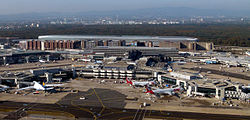
Back Транспарт у Германіі Byelorussian Транспорт в Германия Bulgarian Doprava v Německu Czech Transports en Allemagne French תחבורה בגרמניה HE Promet Njemačke Croatian Németország közlekedése Hungarian Transportasi di Jerman ID Trasporti in Germania Italian 독일의 대중교통 Korean
This article needs additional citations for verification. (August 2016) |



As a densely populated country in a central location in Europe and with a developed economy, Germany has a dense transport infrastructure.
One of the first limited-access highway systems in the world to have been built, the extensive German Autobahn network has no general speed limit for light vehicles (although there are speed limits in many sections today, and there is an 80 km/h (50 mph) limit for trucks). The country's most important waterway is the river Rhine, and largest port is that of Hamburg. Frankfurt Airport is a major international airport and European transport hub. Air travel is used for greater distances within Germany but faces competition from the state-owned Deutsche Bahn's rail network. High-speed trains called ICE connect cities for passenger travel with speeds up to 300 km/h. Many German cities have rapid transit systems and public transport is available in most areas. Buses have historically only played a marginal role in long-distance passenger service, as all routes directly competing with rail services were technically outlawed by a law dating to 1935 (during the Nazi era). Only in 2012 was this law officially amended and thus a long-distance bus market has also emerged in Germany since then.
Since German reunification substantial effort has been made to improve and expand transport infrastructure in what was formerly East Germany.[1] Due to Germany's varied history, main traffic flows have changed from primarily East-West (old Prussia and the German Empire) to primarily North-South (the 1949-1990 German partition era) to a more balanced flow with both major North-South and East-West corridors, both domestically and in transit. Infrastructure, which was further hampered by the havoc wars and scorched earth policies as well as reparations wrought, had to be adjusted and upgraded with each of those shifts.
Verkehrsmittel (German: [fɛɐ̯ˈkeːɐ̯sˌmɪtl̩] ⓘ) and Verkehrszeichen - Transportation signs in Germany are available here in German and English.
- ^ bundesregierung.de - The federal government says 40% of €164,000,000,000 spent on transport infrastructure where spent in the eastern part
© MMXXIII Rich X Search. We shall prevail. All rights reserved. Rich X Search